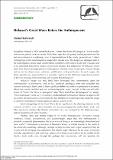Hokusai's Great Wave Enters the Anthropocene
Author(s)
Helmreich, Stefan
Download203Helmreich.pdf (1.961Mb)
PUBLISHER_CC
Publisher with Creative Commons License
Creative Commons Attribution
Terms of use
Metadata
Show full item recordAbstract
Katsushika Hokusai's 1829 woodblock print, “Under the Wave off Kanagawa,” is the world's most iconic portrait of ocean waves. It has been reproduced, quoted, and repurposed over the last two centuries in a widening circle of representations of the unruly, powerful sea. Today's reimaginings of this storied Japanese image often remark upon the dangerous, damaged state of the contemporary ocean. Such commentaries sometimes refer directly to the 2011 tsunami and to its associated Fukushima nuclear power plant disaster. But adaptations of Hokusai's Wave these days also increasingly point to more general anxieties about catastrophic climate change and to worries about ocean pollution, acidification, and plastification. In such usages, the Wave operates as a synecdoche for, a symbolic capture of, the difficult-to-apprehend vastness of the ever-moving, interconnecting, and possibly threatening sea.
Date issued
2016-05Department
Massachusetts Institute of Technology. Anthropology Program; Massachusetts Institute of Technology. Department of Humanities; Massachusetts Institute of Technology. School of Humanities, Arts, and Social SciencesJournal
Environmental Humanities
Publisher
Duke University Press
Citation
Helmreich, Stefan. “Hokusai’s Great Wave Enters the Anthropocene.” Environmental Humanities 7, no. 1 (2015): 203–217. © 2105 Stefan Helmreich
Version: Final published version
ISSN
2201-1919
2201-1919